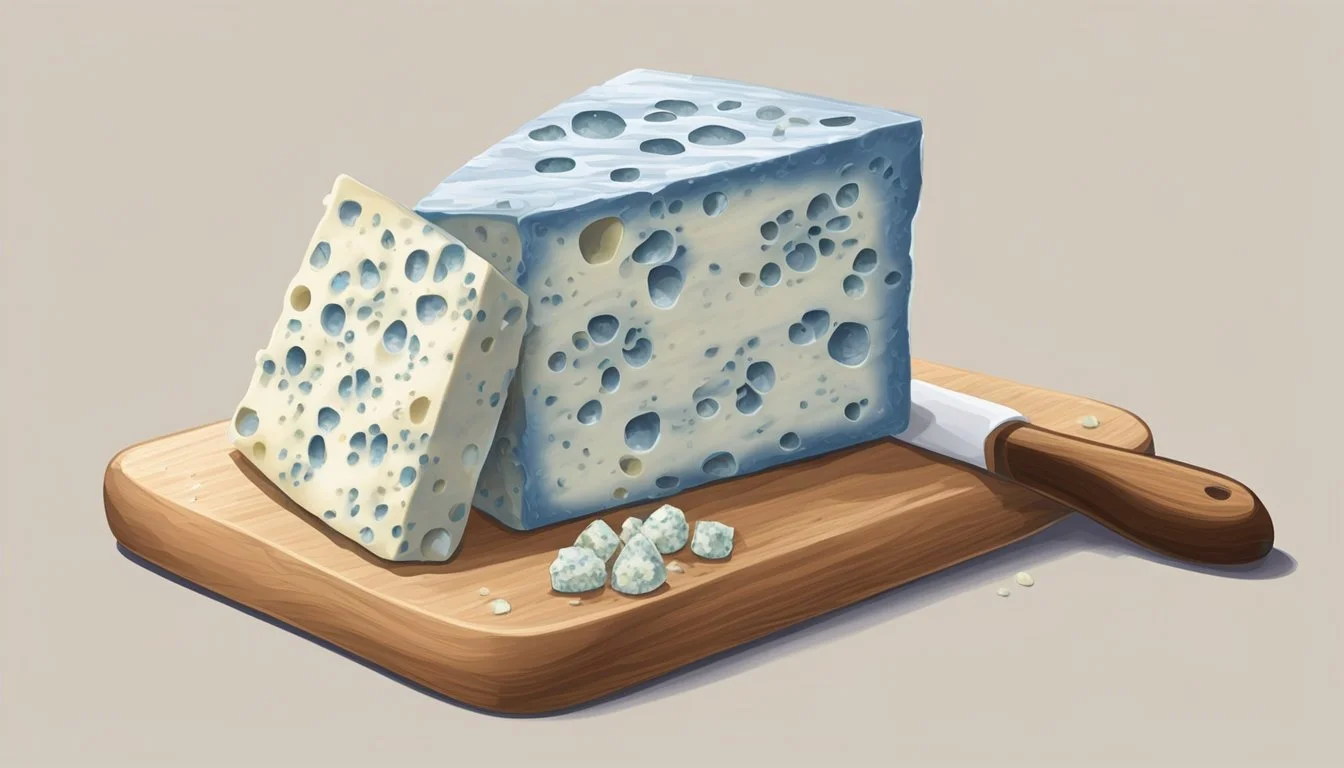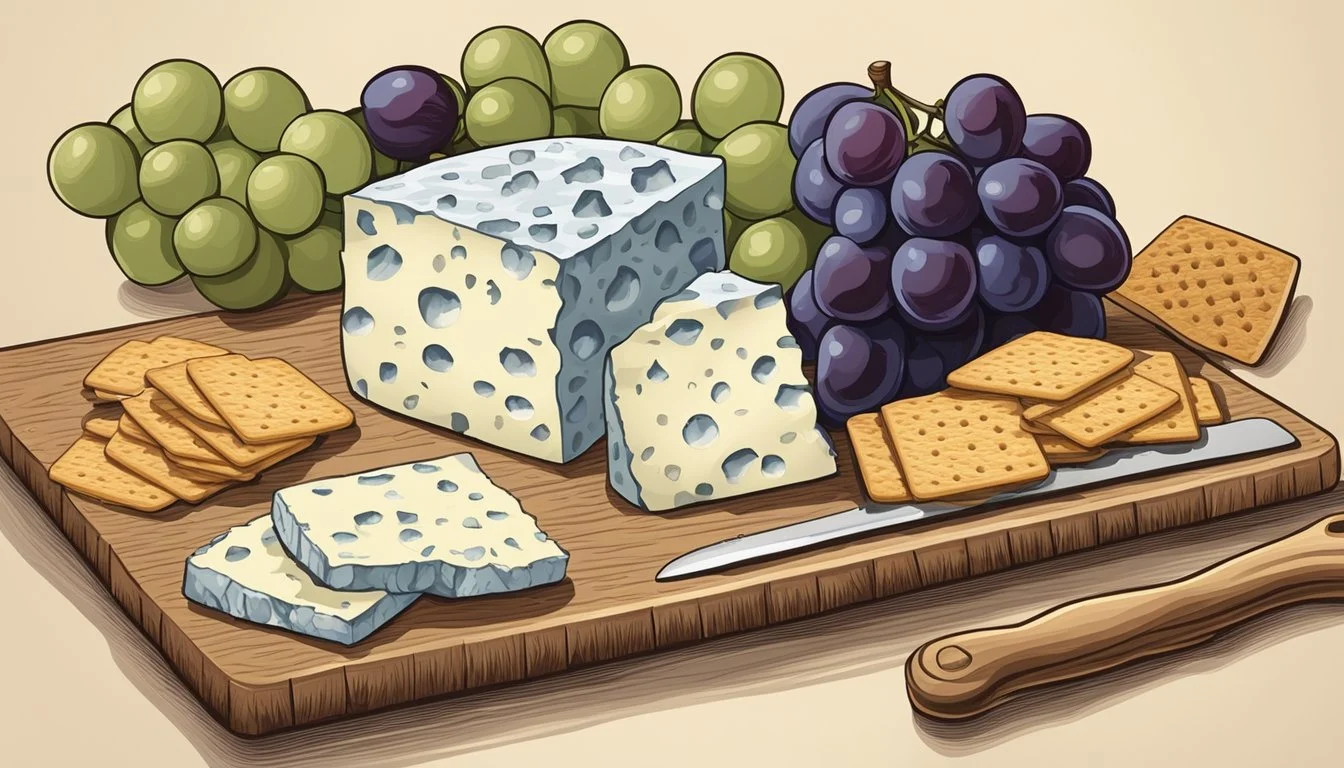How Long Does Blue Cheese Last?
Shelf Life and Storage Tips
Blue cheese (What wine goes well with cheese?) is a distinct type of cheese known for its pungent aroma and striking blue veins, which are the result of beneficial mold cultures added during the cheese-making process. The shelf life of blue cheese varies depending on whether it's sold in a whole wheel, pre-crumbled, or cut into wedges. Generally, an unopened whole wheel of blue cheese can last for several weeks beyond its "sell by" date if stored properly in the refrigerator, often up to three to four weeks.
Once a wedge of blue cheese is opened, the presence of air and moisture can encourage the growth of both the desired molds specific to blue cheese and potentially harmful bacteria. Typically, an opened package of blue cheese should be consumed within one to two weeks. The key to extending the life of blue cheese lies in proper storage. The cheese should be kept in the refrigerator at a temperature between 35°F and 40°F, wrapped in parchment or wax paper to allow it to breathe, and then placed in a plastic bag to retain moisture.
It is crucial to recognize when blue cheese has gone bad, as spoiled cheese can cause foodborne illness. Signs of spoilage include the presence of an off smell that is different from the naturally strong, tangy odor of blue cheese, any visible signs of pink, green or black mold that differs from the characteristic blue or green veins, and a significant change in texture, such as becoming excessively hard or slimy. If any of these signs are present, the cheese should be discarded.
Types of Blue Cheese
Blue cheese comes in a variety of distinct styles, each with its unique characteristics and flavor profile. Certain varieties, such as Gorgonzola, Roquefort, and Stilton, stand out for their historical significance and popularity.
Gorgonzola
Gorgonzola, hailing from Italy, is one of the oldest known types of blue cheese. Made from cow's milk, it presents a spectrum from creamy and mild (Gorgonzola Dolce) to more mature and assertive (Gorgonzola Piccante). Gorgonzola Dolce, the softer variety, offers a shorter shelf life compared to its firmer counterpart.
Roquefort
Roquefort cheese is a revered French blue cheese made from the milk of the Lacaune breed of sheep. Distinctively recognized by its intense, earthy flavor and crumbly texture, Roquefort is aged in the natural Combalou caves of Roquefort-sur-Soulzon. It proudly carries a Protected Designation of Origin (PDO) status, ensuring its time-honored production methods are strictly adhered to.
Stilton
Originating from England, Stilton is another blue cheese granted with a PDO status, meaning that it can only be produced in the counties of Derbyshire, Leicestershire, and Nottinghamshire. This cheese has two varieties: the crumbly and milder Blue Stilton, often enjoyed with port wine, and the creamier White Stilton, typically infused with fruits like apricots for added sweetness.
Blue Cheese Characteristics
In exploring the characteristics of blue cheese, one examines its unique flavor profile, distinct texture and appearance, and the role of edible mold. These aspects define the cheese's identity and influence its culinary uses.
Flavor Profile
Blue cheese is renowned for its bold and tangy flavor that can vary from sharp and salty to slightly sweet with a pungent kick. The presence of blue mold contributes to its depth of flavor, often described as earthy or musty.
Texture and Appearance
The texture of blue cheese can range from creamy and soft to crumbly and firm, influenced by aging and specific varieties. In appearance, it displays characteristic blue or blue-green veins of mold throughout the rich, often ivory-colored body of the cheese.
Edible Mold
The edible mold in blue cheese, primarily Penicillium roqueforti or Penicillium glaucum, is responsible for the signature blue veins. This blue mold, integral to the cheese's structure, is not only safe to eat but also essential in developing its distinct taste and aroma.
Storage Fundamentals
Proper storage extends the lifespan of blue cheese, maintaining its quality and taste. The following conditions are crucial for the optimal preservation of blue cheese.
Ideal Conditions
Temperature and Humidity: Blue cheese should be stored at a constant temperature of 35°F to 45°F (2°C to 7°C) with moderate humidity. This environment mimics the natural conditions of cheese caves, which is conducive to the maintenance of its texture and flavor.
Refrigerator vs. Room Temperature
Refrigerator Storage: It is recommended to store blue cheese in the refrigerator, specifically in the crisper drawer which offers a more consistent environment.
Failure to Refrigerate: At room temperature, blue cheese deteriorates rapidly and is more susceptible to spoilage and bacterial growth. Therefore, it should not be kept at room temperature for extended periods.
Airtight Containers
Preferred Packaging: For short-term storage, wrapping blue cheese in cheese paper, parchment paper, or wax paper, and then placing it in a plastic bag or airtight container, prevents moisture loss while allowing the cheese to breathe. This can be crucial in preventing ammonia smells and off-flavors.
Long-Term Storage: For greater longevity, encasing the cheese in heavy-duty aluminum foil and storing it in an airtight container protects the cheese from freezer burn if placed in the freezer.
Container Importance: An airtight container is key in preventing the cheese from absorbing other odors inside the refrigerator while maintaining the required humidity levels.
Shelf Life and Freshness
The longevity of blue cheese and its freshness largely depend on how it is stored and its state of packaging—at times it can last beyond its printed dates. Consumers should be aware of the various storage methods that can extend the cheese's shelf life while maintaining its quality.
Unopened Blue Cheese
Shelf life for unopened blue cheese can range from 1 to 6 months, depending on its packaging and storage conditions. An unopened package should keep its quality until the expiration date listed on the label and may potentially remain fresh for an additional 2 to 3 weeks if refrigerated properly.
After Opening
Once the packaging is opened, blue cheese should be consumed within 3 to 4 weeks. To maintain freshness, it should be wrapped in parchment or wax paper and then encased in plastic wrap or a plastic bag before storing in the refrigerator.
Freezing Blue Cheese
For long-term preservation, blue cheese can be frozen. Here's a step-by-step on how to freeze blue cheese:
Wrap blue cheese in heavy-duty aluminum foil or parchment paper.
Place the wrapped cheese inside a freezer bag to protect against freezer burn.
Label the bag with the freezing date.
Frozen blue cheese can last for several months but might experience a change in texture. It is best used in cooked dishes after freezing.
Signs of Spoilage
Knowing when blue cheese has gone bad is crucial to avoid consuming spoiled food. This section provides specific indicators to identify whether the cheese should no longer be consumed.
Odor Changes
Blue cheese is known for its strong, distinct aroma. However, if the cheese emits an ammonia-like smell or becomes excessively pungent, this is a strong sign of spoilage. Such changes indicate that the cheese has undergone undesirable bacterial action.
Color and Texture Alterations
A fresh blue cheese has a characteristic greenish-blue or bluish-gray color and a firm, crumbly texture. Signs of spoilage include:
Color: The appearance of brown, yellow, or red spots.
Texture: A change to a slimy or excessively soft texture, different from its original firmness.
These changes can suggest the presence of harmful bacteria and the onset of spoilage.
Mold Growth Beyond Edible
While blue cheese contains edible mold, the appearance of mold that is not original to the cheese is concerning. Types of concerning mold include:
Strange Colors: If one spots mold in colors like pink, green, yellow, or black that was not there before.
Excessive Coverage: An overall fuzzy mold growth, especially on the cut surfaces, is not a positive sign.
Blue cheese's edible mold should look intentional and consistent with the product's original appearance, not as an irregular growth.
Health and Consumption
When considering the health and consumption of blue cheese, it is critical to adhere to food safety guidelines to maintain its quality and ensure it is safe to eat. Proper storing techniques are vital to prevent food poisoning and protect against cross-contamination.
Food Safety Guidelines
Blue cheese should be stored at or below 40°F, typically in the refrigerator, to maintain its quality and safety. It is recommended to consume blue cheese within 3 to 4 weeks after opening or according to the expiration date. Blue cheese made from unpasteurized milk might carry bacteria, so one should only consume pasteurized varieties to reduce the risk of foodborne illness, especially for vulnerable populations such as pregnant women and immunocompromised individuals.
For unopened blue cheese, the shelf life can be estimated to be about 1 to 6 months, based on its packaging and storage conditions. It is essential to keep the cheese wrapped tightly to prevent exposure to air, which can affect the protein structure and lead to spoilage.
Food Poisoning Risks
The risks of food poisoning from blue cheese increase if the cheese is improperly stored or consumed past its prime. Mycotoxins, potentially harmful substances produced by molds, can be present in spoiled cheeses. To minimize these risks, one should:
Inspect: Check for changes in texture, color, or smell before consumption.
Avoid Cross-Contamination: Use clean utensils and cutting boards when handling blue cheese to prevent the spread of bacteria.
Discard: Throw away any cheese that seems off in appearance, smell, or taste, to ensure one does not consume spoiled or contaminated blue cheese.
By following these guidelines, consumers can enjoy the unique flavor of blue cheese while maintaining food safety.
Blue Cheese Utilization
Proper utilization of blue cheese can enhance various dishes, from salads to main courses. This section explores its culinary applications, specifically focusing on incorporating blue cheese in recipes and creating both homemade and commercial blue cheese dressings.
Consuming Blue Cheese in Recipes
Blue cheese's distinct flavor and creamy texture make it a versatile ingredient for a range of recipes. Salads often incorporate blue cheese, either crumbled over the top or mixed within the dish. Burgers and steaks can be elevated with a slice of blue cheese, melting slightly under the heat to add a rich, savory note. For appetizers, blue cheese pairs well with fruits, such as pears or apples, for a blend of sweet and tangy flavors.
When cooking with blue cheese, one must be mindful of its strong taste. It's recommended to balance it with milder ingredients or use it sparingly to complement, rather than overpower, the dish. Here's a simplified guide to using blue cheese in recipes:
Salads: Add 1/4 cup of crumbled blue cheese to a salad for 4 servings.
Steaks/Burgers: Top with 1 ounce of blue cheese per portion just before serving.
Appetizers: Serve blue cheese with fruit or crackers, allowing a small wedge for each guest.
Making Blue Cheese Dressing
Homemade Blue Cheese Dressing typically combines crumbled blue cheese with ingredients like mayonnaise, sour cream, buttermilk, vinegar, garlic, and seasonings to create a rich and tangy sauce. It's commonly used as a dip for veggies or wings, and as a dressing for salads. The consistency can be adjusted by the ratio of liquid ingredients to cheese, according to one's preference.
A simple homemade blue cheese dressing recipe could include:
1/2 cup sour cream
1/2 cup mayonnaise
1/4 cup buttermilk
1 cup crumbled blue cheese
1 tablespoon white vinegar
1 garlic clove, minced
Salt and pepper to taste
Mix all the ingredients, adjusting the amount of blue cheese and buttermilk to achieve the desired flavor and consistency.
Commercial Blue Cheese Dressing is available in bottles and is typically made with a similar combination of ingredients. It has a longer shelf life due to preservatives and can be a convenient option for those seeking quick meal preparation. When purchasing commercial dressings, it's important to check the expiration date to ensure freshness, as opened bottles should be consumed within a month for optimal taste.
Handling Leftovers
When managing leftovers, particularly blue cheese, it's imperative to employ proper refrigeration techniques and to be aware of the cheese's longevity once it's been used.
Refrigerating and Wrapping
For optimal preservation of blue cheese leftovers, one should wrap the cheese carefully. Initially, blue cheese should be wrapped in parchment or wax paper to allow it to breathe and then secured in plastic wrap or placed inside a plastic bag to maintain humidity. These leftovers are best stored in the refrigerator's crisper drawer to help maintain an appropriate level of moisture and prevent the mingling of odors.
Wrap Steps:
Blue cheese in parchment or wax paper.
Enclosed in plastic wrap or bag.
Stored in the crisper drawer.
Cheese Longevity Post-Use
Once blue cheese is opened or removed from its original packaging, the typically expected shelf life is approximately 3 to 4 weeks when stored correctly in the refrigerator. Leftover blue cheese should be inspected for any signs of spoilage—such as an off smell or the presence of mold not typical to the variety—before consumption. It’s essential to keep track of when the cheese was first opened to avoid accidentally consuming spoiled cheese.
Frequently Asked Questions
In this section, we address some common queries about the longevity and preservation of blue cheese. Readers will find specific storage guidelines, safety considerations, and tips for freezing to make informed decisions about their blue cheese.
Blue Cheese Variations in Shelf Life
The shelf life of blue cheese depends on its form and storage. An unopened wedge from the wheel can last 1 to 6 months when refrigerated properly. However, once opened, it is best consumed within 3 to 4 weeks. In contrast, crumbled blue cheese typically has a shorter lifespan, lasting around 1 to 2 weeks in the refrigerator due to a larger surface area exposed to air and bacteria.
Is It Safe to Consume Blue Cheese with Ammonia Smell?
It is not uncommon for blue cheese to develop a noticeable ammonia smell, especially as it ages. This scent is a result of the natural breakdown of proteins by the bacteria present in the cheese. A slight ammonia odor can be normal, but if it becomes overpowering, it indicates that the cheese is past its prime and should not be consumed for safety reasons.
Can Blue Cheese Be Frozen and Thawed?
Blue cheese can be frozen, extending its shelf life significantly. To freeze blue cheese, one should wrap it in parchment or wax paper, followed by enclosing it in plastic wrap or a plastic bag to prevent freezer burn. When thawing, it should be done gradually in the refrigerator. The texture might become more crumbly and less creamy, making it more suitable for cooking purposes, such as baking, rather than for fresh cheese platters.








